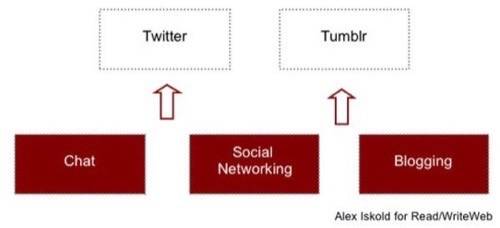Fred Wilson recently wrote a post on his blog in which he argues that the rapid adoption of Twitter and Tumblr were not accidents. Fred sees these microblogging platforms as a
direct evolution of blogging and social networks. Recently, I’ve been mulling over similar thoughts.
Clearly, the success of these sites was not accidental; because they took off in a crowded market, these were things that people obviously needed.
The image above is by Fred Wilson.

In this post, we will argue that each category – blogs, social networks and microblogs – forms a separate vertical.
Each vertical is focused on a different type of user and serves to fill a different purpose in the bigger landscape
of social publishing.
Prehistory – Web Sites
Remember the days in which the more technically inclined of us had web sites?
I went through 3 or 4 different versions of my site with about the same content – books I liked,
software I’d written, my resume, and my photos. Making a web site was not very difficult if you knew HTML,
but was nearly impossible if you did not. The WYSIWYG web site tools never quite worked as expected
and in the end people found them unappealing.

Yet, quite a few people did have personal web sites back in the earlier days of world wide web. The biggest problem
with those sites, however, was that they were static. The content of a site rarely changed, and even when it did,
there was no way for other people to find out. As a result, personal web sites really never caught on with mainstream web users.
That all changed when blogs burst on the scene.
Blogs as Online Diaries
Blogs worked because they were like diaries.
Content is presented in reverse chronological order (with the latest content on top). This single fact alone made a big difference, because it quickly showed readers how content was changing and being updated.
The other thing blogs got right was templates. One of the difficulties in making web sites is that
there is an enormous number of ways in which content can be presented, and for people who are not technically savvy
this presents a barrier. Templates solve this problem because pre-structured content leaves less room to screw things up.

So, blogging platforms made it easier for people to publish online without having to deal with HTML. Liberated from the need to deal with technical quirks, people finally had the chance to focus
on the content. And they did. Blogging took off in a major way around 2003-2004. At the time, it was really the only
only way to do personal publishing online.
Social Networks Take Personal Publishing Mainstream
Social networks arrived next and reached a much wider audience than blogs.
The reason for this is that social networks are publishing systems where the content is produced automatically
as the consequence of social interactions. For example, writing on a Facebook Wall is a form of
personal publishing, but we just don’t generally look at it in that way. We think of it as a message sent to a friend, but an aggregate
of all the messages that we leave amounts to a chunk of our online personal publishing. Posting a photo or a video is no
different, as it is an act of creating personal content.

The trick is that social networks do not emphasize the publishing angle. They focus on the social bits.
The publishing occurs in the context of socializing and therefore is transparent. More important, it is perceived
as easy. Writing a long blog post is much harder than posting a photo. It is this ease of content creation that
immediately made social networks appealing to the mainstream as a method of online content publishing.
Microblogging Jumps in the Middle
Despite the fact that content creation in social networks is very easy, it has a very different purpose and
very different feel from blogging. In social networks the informational bits are scattered, but in blogs, they are focused
and organized sequentially. Social network publishing is very terse, blog publishing is verbose. Is there a form
of publishing which is on one hand as easy as social networking, but as sequential as regular blogs?
Twitter and Tumblr have recently emerged to define this new category of microblogging.

Characterized by ease of use and compactness, these new forms of communication are racing to fill a niche
between blogs and social networks. In addition to the standard publishing, which both borrowed from blogs, both services have
taken ideas from social networking sites, as well, allowing people to remix and see each other’s content.
Twitter has mashed up communication and personal publishing to create a compelling new form of real-time publishing.
The idea of expressing of what you are doing right now in less than 140 characters is clever, but remixing
other users’ posts and allowing people to subscribe to each other’s messages was the stroke of genius that made Twitter a hit.
But while Twitter is probably a descendant of a chat and social networking, Tumblr is a direct remix of blogging and
social networking.

Tumblr dramatically simplifies blogging in the same way that blogs simplified web sites.
Unlike traditional blogging software – Blogger, Typepad, WordPress, MoveableType – Tumblr posts are much more focused
and shorter. The simplicity is achieved by focusing each post on a single object – a photo, a video, a link, a quote, or
a piece of text. Tumblr supports rich text editing, but it has been downplayed in favor of quick posting. It is also
possible to have widgets and other stuff present in your Tumblr’s sidebar, but most Tumblr blogs do not use them, favoring instead a clean, bare look.
The point is to simplify blogging by focusing on the personal lifestream, the essence of personal content.
Verticalization of Everything
Coming back to Fred Wilson’s observation – the emergence of microblogging is not an accident.
It represents a well known trend of verticalization. When new markets form they continue to be partitioned into
niches. Since the gap between blogging and social networking was very wide, and the audience was quite different,
microblogging emerged. Tumblr in particular defines a new class of users. These are people who may be daunted
by the complexity of blogging platforms, but want more than the primitive publishing offered by social networks.
In addition, Tumblr is appealing to users like myself, who use blogging platforms professionally, but are happy
with a lighter solution for a personal blog.

In terms of ease of use and elegance of delivery, Tumblr certainly fills its niche. The bigger question is,
would people find the social aspects of Tumblr interesting? On one hand, as Fred Wilson points out, the fact that
your personal stream is mixed with other people’s streams is cool. Beyond cool, however, is there a value in seeing small,
random bits from other people’s lives? This is different from reading people’s blogs, where posts seemed to be
lengthier and more topical. Yet, the answer is likely still to be yes.
Conclusion
The personal publishing market evolved from cumbersome web sites to online diaries called blogs to social networks and more recently to microblogs.
Each form of personal publishing is different and each has its niche and audience. While social networks have been the most wide spread,
the content creation there feels different from publishing. Because traditional blogging platforms are powerful and
still require technical know-how, microblogging has evolved as an intermediate form of self-publishing.
Microblogging has a shot of spreading blogging further into the mainstream as well as swaying some professional bloggers to start personal blogs.
It will be interesting to see what will to happen to microbogging in 2008. Do you think it is going to take off?
Do you have a Tumblr blog today? Are you likely to get one soon? Do you use Twitter?
Disclosure: Fred Wilson is a managing partner of Union Square Ventures, a fund which invested in Alex’s company AdaptiveBlue,
as well as Twitter and Tumblr.





















